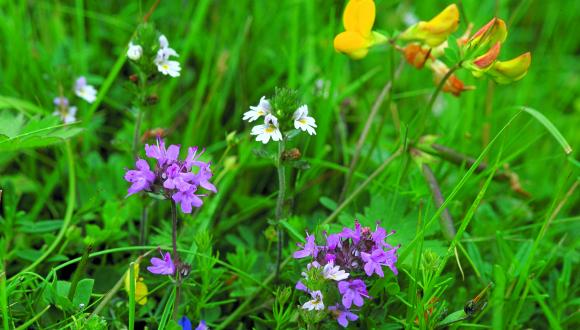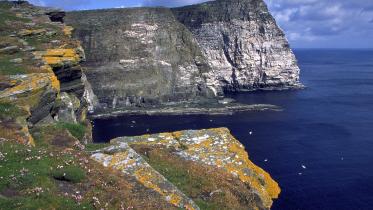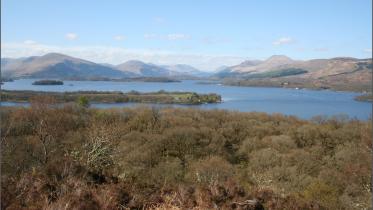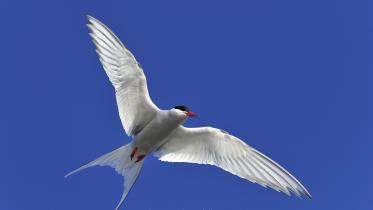Species Rich Grasslands guidance leaflet
Species Rich Grasslands - What they are and why they matter
Species rich grasslands were once common in Britain but over 97% have been lost in less than a century. This is devastating for the hundreds of plants, invertebrates and fungi species which rely on these important habitats. To support a healthy and biodiverse ecosystem, identifying and caring for remaining meadow fragments is essential.
Species rich grasslands have a high diversity of native wildflowers and grasses, which have co-evolved with traditional farming techniques over the last 6000 years. They are capable of supporting healthy populations of insects, birds, bats, amphibians and many other animals. Grassland soils also provide us with useful ecosystem services by sequestering carbon, locking up harmful pollutants, improving pollination on surrounding farmland and holding back floodwaters.
Despite being part of our natural and cultural heritage, species rich grasslands have been disappearing rapidly since the end of the first world war. Around 7.5 million acres of wildflower meadow have already been lost and many more are still being destroyed today. Remaining grasslands which are still in good condition typically exist as small fragments, making them particularly vulnerable.
Species rich grasslands are undervalued and to the untrained eye, can be difficult to identify. To protect these special habitats for future generations we must inspire landowners to feel passionate about their grasslands and manage them sympathetically.
How to Identify Species Rich Grasslands
Scotland has many different types of grassland, influenced by factors such as location, soil pH, underlying geology and how waterlogged the ground is. Some grassland types are rarer than others, but each contain characteristic indicator species to aid identification.
Acid grasslands
Are identified by Tormentil and Heath Bedstraw, growing amongst fine-leaved bent and fescue grasses. There is less wildflower variety when it comes to acid grassland, but they can feature Harebells, Devils-bit Scabious, Dog Violet, Bitter Vetch and Sheep’s Sorrel.
Neutral grasslands
Contain a great variety of colourful wildflowers, of varying heights. Common species include Knapweed, Yellow Rattle, Bird’s-foot Trefoil, Lady’s bedstraw, Meadow Buttercup, Yarrow and Self Heal. Beautiful orchids such as the Greater and Lesser Butterfly Orchid may also be found in good quality neutral meadows. Grasses include Crested Dog’s Tail, Yorkshire Fog and Sweet Vernal Grass – the latter responsible for the characteristic scent of freshly mown hay.
Calcareous grasslands
Are less common and typically follow the distribution of calcareous rocks and soil along steep slopes, rocky outcrops and riverbanks. This grassland type is rich in small herbs, with Wild Thyme, Rock Rose, Lady’s mantle, Fairy Flax and Field Gentian being good indicators. There may also be sedges and quaking grass which trembles distinctively in the wind.
Purple moor grass and rush pasture
Will contain tall herbs like Angelica, melancholy thistle, Meadowsweet, Greater Bird’s-foot Trefoil, Marsh Bedstraw and Sneezewort amongst Sharpflowered Rush. The most common grasses are Purple Moor grass and Yorkshire Fog. Found on poorly drained sites.
What other wildlife might I see?
Species rich grasslands provide food and shelter for all stages of the insect life cycle and are usually abundant in pollinators. Look out for bumblebees, hoverflies, butterflies and day-flying moths. You may also spot rare species depending on location; the west coast supports good populations of the beautiful Marsh Fritillary Butterfly, whilst the Small Scabious Mining Bee may be found in the Cairngorm National Park. Small mammals, birds, amphibians and bats are attracted to the abundance of plants and insects. Ground nesting birds such as Snipe and Skylark also depend on grasslands to breed.
Grassland Biodiversity
Species poor grasslands are easy to recognise, as they are typically bright green in colour and have a low diversity of native grasses and wildflowers. They often contain a dominant crop for feeding livestock such as perennial ryegrass – however there are many different threats to species rich grasslands.
Species rich grasslands can be degraded very quickly through agricultural improvements such as reseeding with a grass crop or applying herbicides and fertilisers. Such “improvements” prevent the growth of wildflowers which cannot outcompete crop species and dislike soils with high nutrient content. Overgrazing by livestock is also detrimental. Another concern in Scotland is the mass planting of both non-native and broadleaf woodland, supported by an ambitious tree planting target from the government. In the above photograph, you can see the grassland has been degraded by a non-native Sitka Spruce plantation, agricultural improvements and overgrazing.
- Threats to Scottish Grasslands:
- Agricultural improvements (re-seeding, fertilising and draining wet areas)
- Urban development (housing, roads and industry)
- Tree planting (both commercial plantations and native broadleaf)
- Damage by livestock (Overgrazing and poaching)
- Undermanagement (no grazing and eventual scrub encroachment)
- Creation of amenity grassland (e.g. golf courses and playing fields)
Species rich grasslands can be maintained or restored using the following management techniques:
- Grasslands do benefit from some management, as rank vegetation will hinder new growth of wildflowers and eventually reduce species diversity. Cut in late summer after flowering or graze over winter.
- Remove grazing during summer months or graze only lightly. This will allow plants to flower and set seed.
- Avoid stock feeding livestock in species rich grassland, which leads to heavily poached ground and colonisation of weed species.
- Wildflowers need to grow in nutrient poor soil, so avoid the application of chemical fertilisers and manure. Removal of grass cuttings will also prevent nutrients from re-entering soil.
- Consider tree planting carefully and choose an appropriate site which will not shade out species rich grasslands. Even with regard to native broadleaf – as replacing one biodiverse habitat with another is counterintuitive.
- Remove gorse scrub and young trees which will regenerate naturally and quickly dominate ungrazed sites. • Where historically rich grasslands have been degraded through agricultural improvements, introduce a cutting regime or consider seeding bare patches with Yellow Rattle – a species which parasitises dominant grasses and improves diversity.
- Avoid herbicide application but if necessary, carefully control weeds such as Dock and Creeping Thistle with a non-drip weed wipe.
Useful Links
Magnificent Meadows for advice on restoring, creating and managing meadows
Plantlife for basic wildflower identification and grassland action plan
Botanical Society of Britain and Ireland for submitting wildflower records
Butterfly Conservation for identifying grassland butterflies and moths
NatureScot pollinator resources
Pages: 7
Published: 2021




